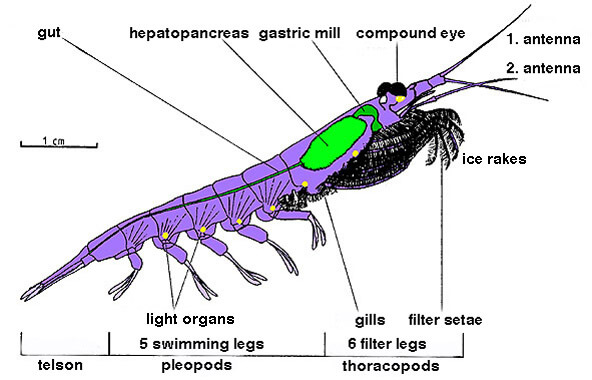What are the characteristics of Crustaceans? Information about classification, reproduction, feeding of Crustaceans.

Body structure of a typical crustacean – krill (Source : wikipedia.org)
Reproduction
In most crustaceans the sexes are separate, but most barnacles are hermaphroditic, with both male and female reproductive organs present in each individual. Sex reversal is widespread among the parasitic isopods and in the shrimp genus Pandalus, individuals functioning first as males and later as females. Sex reversal with the female phase first occurs in the isopodlike tanaidacean Tanais stanfordi and in the isopod Cyathura carinata.
Development
Most crustaceans develop from fertilized eggs, but in some forms, panthenogenf-sis, or development from unfertilized eggs, occurs regularly. The newly hatched young may resemble the adult, but more often it differs markedly in appearance. The earliest larva is called the nauplius; it has an unsegmented body, median eye, and three pairs of appendages (first and second antennae, mandibles). Then the body elongates, its posterior part becomes segmented, and additional appendages are added. The larva is now called a metanauplius. In barnacles the last metanauplius becomes the ostracodlike cypris larva which attaches to a solid object and metamorphoses into an adult. In euphausiids (krill) and decapods (shrimps, lobsters, and crabs) the metanauplius is followed by larval stages in which all trunk segments are present and the first six pairs of appendages are functional.
In these stages the larvae are called zoeae, and the abdominal appendages are absent or rudimentary. In the postlarval stage, which follows the final zoeal stage, the zoea transforms into a megalops in crabs and into a mysis in shrimps. The above pattern of three juvenile stages—naupliar, zoeal, and megalopal or mysid— is often modified by the suppression of one or more stages. In most decapods the naupliar stages are passed in the egg, and the young hatch as zoeae. Freshwater decapods have direct development, as do the Peracarida (amphipods, isopods, mysids), which brood their young in thoracic pouches.
Molting
Because of its hard outer skeleton, a crustacean can increase in size only immediately after molting, or shedding, of the old skeleton, while the new skeleton is still soft and extensible. To break out of the old skeleton, the animal swells rapidly by taking up water. The new skeleton, which, with the exception of the uncalcified layer (see section Cuticle), was laid down beneath the old one before molting, then becomes hardened and calcified. Before molting, minerals are dissolved from the old skeleton and stored for later use in the new skeleton. They are stored either in the hepatopancreas or, in crayfishes, in stony objects in the stomach called gastroliths. A complex endocrine system regulates the cycle of molting.
Feeding
The lower Crustacea most commonly feed by straining small particles from the water with their limbs. This method, called filter-feeding, is accomplished in many different ways. Fairy shrimps set up a food current in a groove at the base of their legs when these appendages beat during swimming. The food moves forward, becomes entangled in a sticky secretion of the upper lip, and is pushed into the mouth by the first maxillae. In many mysids (opossum shrimps) the rotation of the outer branches of the thoracic legs during swimming sends a current into the food groove; the current is then moved forward by vibrations of the second maxillae. Food is trapped on the second maxillae and scraped off by the other mouthparts. In some copepods the second maxillae strain a cur> rent established by swimming movements of the anterior (front) mouth appendages. Other crustaceans filter the water with the anterior thoracic legs, the maxillipeds, the first maxillae, or both pairs of antennae.
In addition to the filter feeders, there are crustaceans that feed on plants and by scavenging, and many are omnivorous. Predation is most common in the larger and more advanced forms, but also occurs in lower Crustacea.
Courtship
Courtship behavior, known to occur in only a few crustaceans, has been studied most intensively in the fiddler crabs.
ORIGIN AND CLASSIFICATION
Although crustaceans have probably existed since the Cambrian period, about 600 million years ago, their origin and relationship to other arthropods (insects, spiders, and others) are obscure. The anatomy of fossil forms is too poorly known to cast much light on crustacean origins, and theories on the subject are highly speculative.
Most authorities agree that the ancestral crustacean was a small animal with a head and a trunk of many similar segments. On the trunk were numerous similar appendages, all of which had several functions—locomotion, feeding, and so forth. The hindermost appendages were probably less well developed than the more anterior ones.
It is possible that the ancestral crustacean resembled the present-day cephalocarids, tiny animals that feed on detritus just above the ocean floor. Their trunk appendages show similarities to those of the trilobites (ancient, extinct arthropods), and suggest that the crustaceans may have originated from the trilobites or from trilo-bitelike ancestors.
Whatever the origin, the ancestral stock probably divided early into several lines, leading to the living major crustacean groups.
The classification of the class Crustacea is still unstable, and the one given in the accompanying box is only one of several that might be given. The old division into Entomostraca and Malacostraca is no longer followed.
mavi